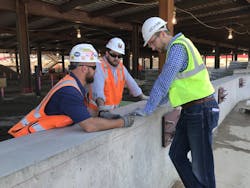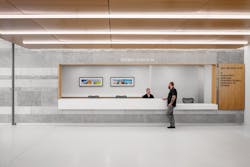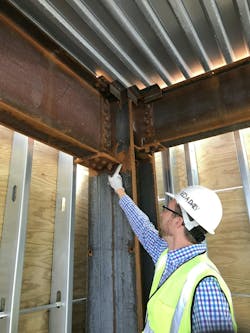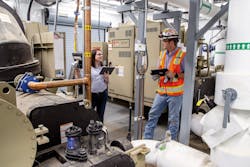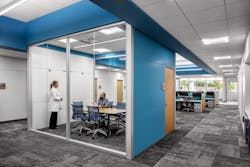First public-private partnership project in Veterans Administration history saves $34 million in costs
SILVER AWARD - 2021 BUILDING TEAM AWARDS
Omaha VA Ambulatory Care Center
Omaha, Neb.
PROJECT INFORMATION
Project cost: $86 million
Construction time: April 2018 to August 2020
Delivery method: CM at risk via P3
BUILDING TEAM
Submitting firms: LEO A DALY (architect, interior architect, SE, MEP) and McCarthy Building Companies (CM)
Owner: U.S. Department of Veterans Affairs
Owner’s representative: VACDC/Heritage Services/Tetrad
Specialty curtain wall manufacturer: Architectural Wall Systems
Judges' Comments
"Connecting the façade elements to the flag and colored glass of the honor wall was a nice touch. The use of P3 for a VA project was a great move, and the involvement of key stakeholders contributed to a good team approach to deliver this project at a much quicker pace than the VA is used to doing."
"Amazing P3 collaboration that resulted in an exemplary design while achieving significant time and money savings – a very rare combination."
"Design recognizes and honors the end users."
VA clinical care facility honors Omaha-region veterans
The Omaha VA Ambulatory Care Center, the first P3 project in the history of the VA system, opened ahead of schedule and under budget in July 2020.
Part of the Veterans Affairs Nebraska–Western Iowa Health Care System, the three-level, 157,000-sf outpatient facility is connected to an existing 12-story VA hospital that opened in 1950. The new facility holds eight primary-care clinics, including one exclusively for women veterans; one specialty-care clinic; and a surgical suite with five operating rooms, including pre/post-op space, radiology, on-site lab, and a satellite pharmacy with retail.
The new state-of-the-art facility relieves the aging hospital of its most common primary-care services. Its architecture expresses gratitude to veterans through symbols of freedom, honor, and duty while creating a wellness-centered atmosphere for patients, staff, and loved ones. The interior environments create moments of comfort, refuge, and reflection.
Energy use was reduced 26.2% below code and meets criteria for LEED Silver. The structure and infrastructure are designed flexibly for future additions and renovations. The design also embodies a few firsts for VA healthcare facilities, including electric lighting whose color temperature warms and cools throughout the day, emulating natural light to convey the passage of time.
The construction team partnered with OSHA’s Omaha Area Office as part of the OSHA Strategic Partnership Program. It was the first time the local OSHA office and Omaha-based construction team participated in this program, which is designed to enhance workplace safety and health practices. Through the partnership, more than 1,325 employees received 4,124 hours of safety training, and the project received no violations from an unannounced OSHA enforcement visit to identify potential hazards on site. In total, the project logged 471,021 man-hours, with zero lost-time incidents and zero recordable incidents.
The project was also completed without shutdowns or delays during the early onset of the COVID-19 pandemic. In response to the pandemic, the construction team modified daily processes, including social distancing practices, distribution of hand sanitizer stations in high-traffic areas, handwashing stations throughout the project, and daily sanitization practices to maximize safety and health for all workers. Coordination and teaming with the design team resulted in final punch-list activities taking place after hours, limiting the number of individuals on the jobsite at the same time.
Teamwork takes on new dimensions
Outstanding teamwork supported the project’s innovative delivery. This is the first healthcare project completed for the U.S. Department of Veterans Affairs using a public-private partnership. Unlike previous VA healthcare projects, the general contractor was selected concurrent to design, starting in 2017, and site work commenced simultaneously. The trailblazing P3 delivery method cut completion time from 52 months to 36 months and total project cost from an estimated $120 million through traditional delivery to the $86 million.
CHIP-IN for Veterans Act enables trailblazing project delivery
In 2010, Congress budgeted $56 million to fund the design process for a new medical center to replace the existing hospital. That project never materialized, but the money allocated for design remained available.
In 2016, Heritage Services, a local nonprofit organization steered by community business leaders, many of them veterans, formed the Veterans Ambulatory Care Development Corporation (VACDC) and worked with bipartisan Congressional representatives to draft P3 legislation, which allowed them to contribute $30 million in private dollars to expedite a project to meet the increasing demand for veteran primary care services. This ultimately led to a first-of-its-kind partnership between the public-sector VA and private-sector VACDC.
The unique approach used to deliver the Omaha VA Ambulatory Care Center would not have been possible without the CHIP-IN for Veterans Act of 2016. Previously, no legal avenues existed to allow private dollars to fund a VA healthcare project. Heritage Services/VACDC worked with legislators to draft the bill, which stipulated that federal funds could be applied if a complete and usable project could be created using a combination of the original $56 million and donated funds.
Forging a new, highly collaborative delivery process
A traditional VA process for this type of project would have taken six months to select a design team, 18 months of design, four months to select a contractor; and 24 months of construction – 52 months from designer selection to construction completion.
The Omaha VA Ambulatory Care Center was delivered in 36 months: four months to develop an agreement between VACDC and the VA, one month to select a design team, nine months of design with a contractor selected concurrent with the design process, and 22 months of construction.
Traditionally, VA healthcare projects have used a rigorous standard process with some flexibility for varying sizes and scopes of projects. In this case, the private donors sought to optimize processes to streamline schedule and reduce costs, while also delivering a project with atypical symbolic architecture that would honor the region’s veterans. The LEO A DALY design team helped tailor a new process that met VA requirements and achieved the goals of the project’s benefactors.
Working together, the VA, VACDC, and LEO A DALY modified the VA’s standard documents line by line, garnering reviews and approvals as needed along the way, and helped develop the construction manager at risk delivery process that was ultimately used to achieve the abbreviated timeline and overall cost savings.
The facility opened in late summer 2020 amid the first pandemic in a century. Since then, the Omaha VA Ambulatory Care Center has been efficiently providing primary-care services to veterans. With capacity to serve about 400 patients per day, it has also helped relieve the main Omaha VA Medical Center of most outpatient services.
The custom-tailored design, delivery, and construction married processes from the public and private sectors, using performance-based specifications while meeting federal requirements such as blast-resistant façades. It also led to a successful first P3 project under the new legislation, which has now become a model for future P3 projects for veteran healthcare. In December 2020, the U.S. Government Accountability Office released a report recommending the VA share lessons learned from the Omaha project. A second P3 project, a 58-bed VA hospital, is under way in Tulsa, with partial funding from a private foundation and the state of Oklahoma.
Achieving excellence through teamwork
An understated source of value from the new process was its collaboration between LEO A DALY and the CM, McCarthy Building Companies. Most VA healthcare projects delineate design and construction. Thanks to close coordination between the design and construction teams, the final project cost was within 1% of the original conceptual budget estimate provided during the project’s design phase. The project team used the Last Planner System (LPS) and pull planning process scheduling techniques to optimize and accelerate the project schedule. These Lean construction practices enabled the team to meet the contractual completion date, despite experiencing 43 days of weather impacts between October 2019 and March 15, 2020.
Early in the design process, McCarthy provided a subsurface utility mapping analysis of the existing below-grade infrastructure for the 70-year-old campus. They identified significant discrepancies between assumptions and actual, as-built conditions. Early communication of these discrepancies to the design team enabled designers to update documents prior to construction. Accurate utility mapping also enabled the construction team to complete the project with zero utility strikes.
Another example of design-construction teamwork came in the decision to use 63-foot steel columns for the superstructure. The design initially called for two column lengths, 26 feet and 37 feet, which would have to be spliced together in the field as the building was erected. Through collaboration, the team decided to combine the two columns into a single column to simplify erection, reduce labor, and speed up construction once the columns were on site. McCarthy confirmed the timely availability of the manufactured steel columns while the design team updated design documents. The simplified fabrication reduced the time, cost, and labor required to erect the columns.
McCarthy and LEO A DALY collaborated closely to select durable, cost-effective materials that simultaneously met energy goals and achieved aesthetic aspirations. A signature curtain wall that forms the western façade, the glass “honor” or “ribbon” wall, incorporates colored film between panes of blast-resistant glass rather than a conventional surface-mounted film. This unique application ensures that the film can’t be scratched or defaced, while maintaining the federal blast rating. Project team members toured other such installations to ensure the material could achieve the intended design aesthetic before employing it.
Another demonstration of teamwork had to do with the structural steel moment connections. Knowing that the steel erection would occur during the winter of 2018-201, LEO A DALY’s structural designers collaborated with McCarthy’s contractors to identify a connection strategy for lateral moment frame structural members. The use of moment connections precluded the use of brace frames or shear walls, which would have protruded into the floor plan and compromised the original architectural design intent. Typically, moment connections are welded, but welding the moment connections in the cold would have required additional metal-heating procedures or risked leaving the welds brittle. The team developed a bolted moment connection option prior to the release of the bid documents that allowed for the fabrication of steel beams and columns with precision-placed holes for bolting the moment connections. This allowed beams and columns to be bolted in the field in sub-freezing temperatures, rather than welded, without impacting the architectural design or the construction schedule.
Toward the end of design, McCarthy used a design-assist contracting method to procure a curtain wall manufacturer for the north undulating (flag) wall. The folded appearance of the curtain wall needed to meet high architectural standards, while the wall’s structural gridwork had to meet engineering thresholds to resist a multitude of forces. The wall’s high aesthetic value and precision structural requirements led to a joint contractor/designer-led selection process to ensure the bidding contractors could provide adequate tooling and expertise to manufacture the wall on schedule and within budget. Early engagement of this subcontractor, Architectural Wall Systems, helped facilitate precision and efficiency on this challenging glass installation. The curtain wall system features 12-inch-deep mullions, with eighth-inch thick extrusions to meet federal blast load requirements. It also needed to mate precisely with the facility’s underlying steel superstructure.
Stakeholders as teammates
Stakeholder outreach included engaging leaders from the VA and VACDC as well as doctors, nurses, administrators, and veterans themselves.
The VA’s vision of creating an exceptional healthcare facility for the community’s veterans was shared by the private-sector donors from VACDC. Traditionally, the VA required all curtain walls to be visually simple and linear. However, the symbolic architecture conceived in early sketches by LEO A DALY was a prime motivator for the private-sector VACDC and the unique P3 delivery, which ultimately led to the precedent-breaking flag wall that forms the north façade.
LEO A DALY engineers also worked closely with the facility’s surgeons, who requested lower than standard temperatures for the operating rooms. To achieve these temperatures while maintaining humidification and pressurization, the designers specified a desiccant dehumidification wheel for the OR air-handling units. They worked with contractors to select a desiccant material that leverages differences in relative humidity, rather than requiring greater energy consumption. Air supply and return in operating rooms use pressure-independent air valves capable of resetting to lower airflows when the rooms are unoccupied, without impacting pressurization requirements.
Before and during design, the Omaha VA Medical Center was in the process of evaluating multiple future utility upgrade projects for its campus. One option under consideration was chilled water from an outside utility to meet campus cooling loads. Mechanical infrastructure needed to offer the flexibility of future outside-utility tie-ins. However, that future construction work could have interrupted daily healthcare operations. The mechanical design incorporated a packaged chilled-water cooling plant located just north of an existing central boiler-plant facility. By designing chilled-water infrastructure as an independent, self-contained plant and locating it near the proposed routing of future utilities, the plant can be bypassed in the future should the VA decide to draw chilled water from a separate utility connection.
Another signature architectural feature is a symbolic interior limestone wall that separates public spaces from secure clinical areas. The wall is composed of layers of sediment that symbolize the foreign soils tracked home by returning veterans. Knowing that the wall would partially block the clinical staff’s access to daylit areas, the designers specified automated controls and tunable white luminaires that adjust lighting color temperatures automatically throughout the day, imitating the warmth of morning daylight, cooling through midday, and warming again in late afternoon – a first for any VA healthcare facility.
Throughout the life cycle of the project, a collaborative culture united the design and construction teams around a shared vision: efficiently delivering an inspirational, healing environment for the region’s veterans.


